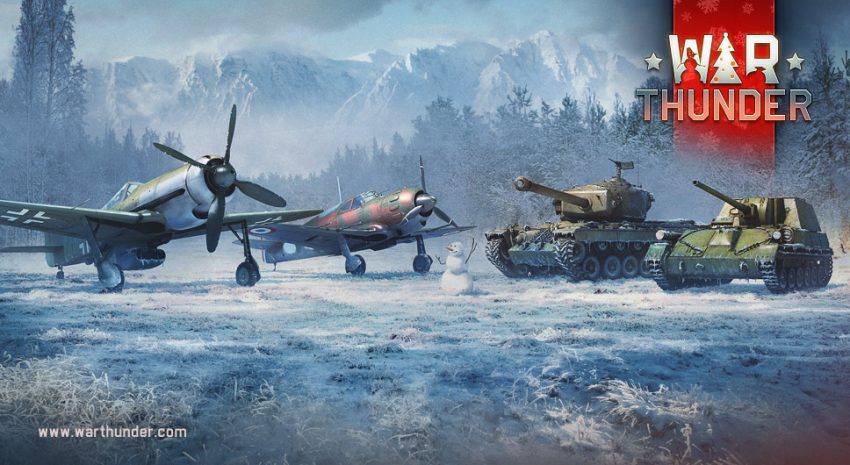A guide of the reserve tanks for all of the trees in War Thunder, how they work and how to become lord king of murder mountain with them.
Seriously, do not doubt the power of the M3 75mm or the M10.
To start off however, we have the one off tank to start you down American light tanks, the LVT(A)(1).
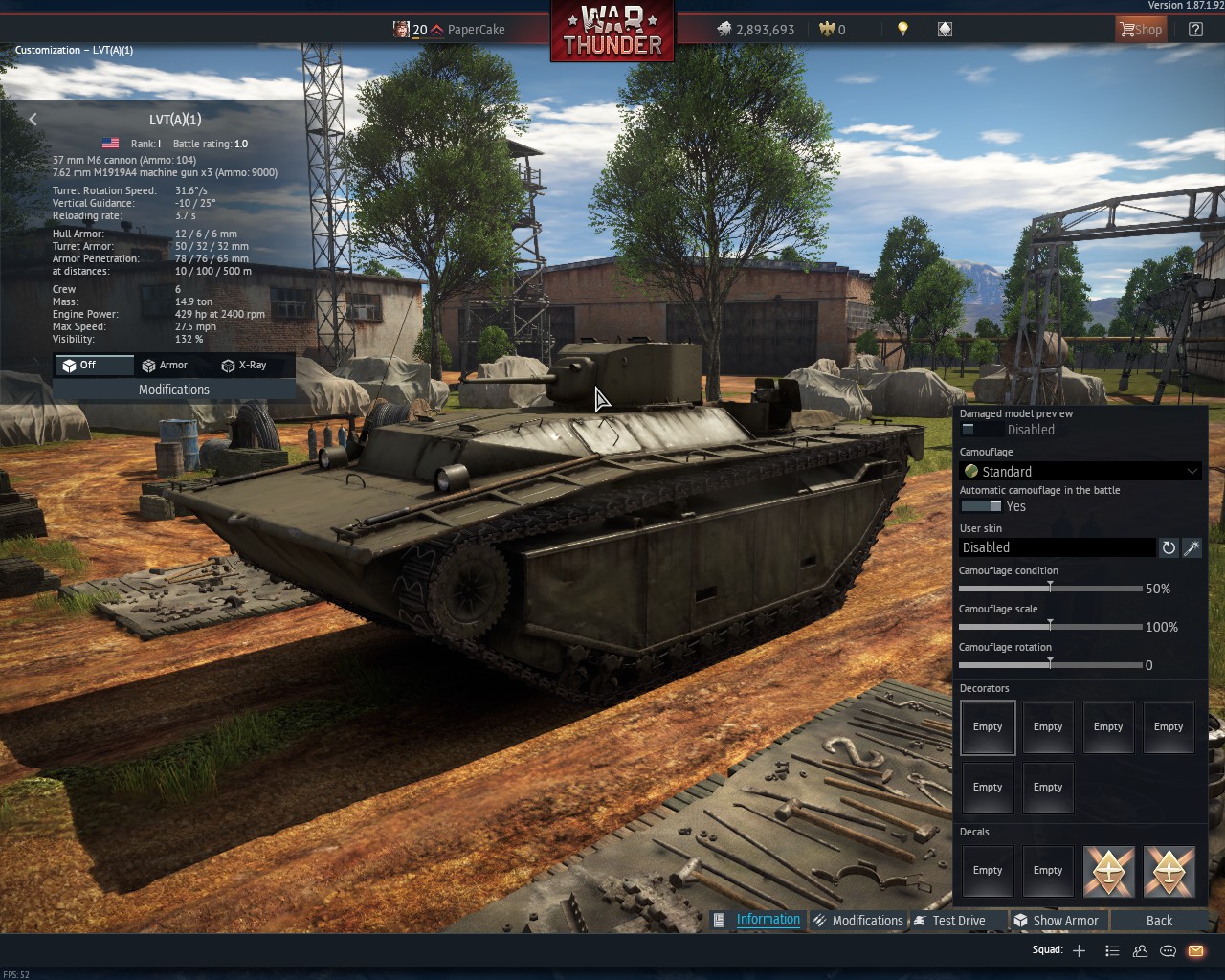
The LVT series of vehicles were landing craft used heavily by the US Marine Corps during the island hopping campaigns in the Pacific. The idea was to have treads for climbing onto beach heads as well as propellers to sail out from landing ships, and these LVT’s would be famously nicknamed “Amtraks” as a result. For fire support, the (A)(1) was developed mounting a M3A1 Stuart turret which was quickly found to lack suitable punch to deal with enemy fortifications which would lead to later variants mounting the turret found on the M8 GMC.
In-game, the LVT’s a fairly potent tank but not really for front line duels. The thin Amtrak armor makes it a target for anyone with a bone to pick and your only advantage is the sheer amount of men that you can pull in once some BT-5 takes out your turret. The 37mm cannon is one of the best starting guns in the game and if you know where to hit, will easily one shot any target you come across. While good, your main RP maker will come with the next tank.
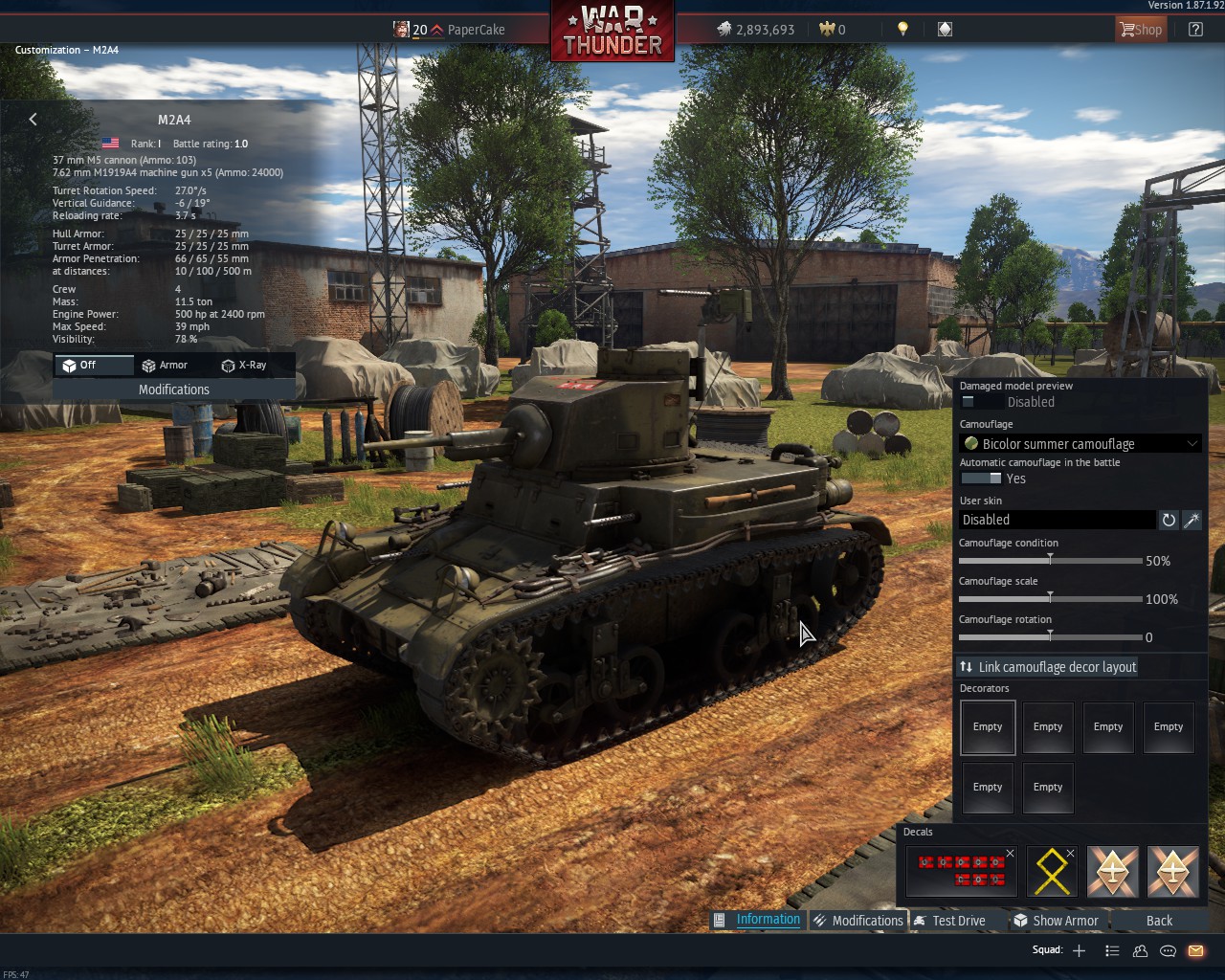
The M2A4 is the final variant of the M2 series of tanks that descend all the way from the original Rock Island Arsenal T2 prototype made in the mid 1920’s. While originally armed with MG’s that you’d see with the M2A2, the Spanish Civil War showed that MG only tanks weren’t viable anymore and most were either shoved in storage or refitted with 37mm cannons. While it had been replaced by the M3 and later M3A1 Stuart, the M2A4 would see use in the Pacific both by the 1st Marine Tank Battalion at Guadalcanal as well as limited issue to British units in Burma and India, although historians doubt they were ever used in mainline combat.
If you want to be a little turd, you take this tank. And don’t take that as an insult, the M2A4 and most of the American light tanks can wreck shop in 1.0 to around 2.0 when 75mm start rolling out. The armor isn’t anything special but the speed of the M2A4 make it pretty quick and the 37mm gun is more than capable of taking out enemy tanks. If you want to be a speedy speed boy, go with this tank.
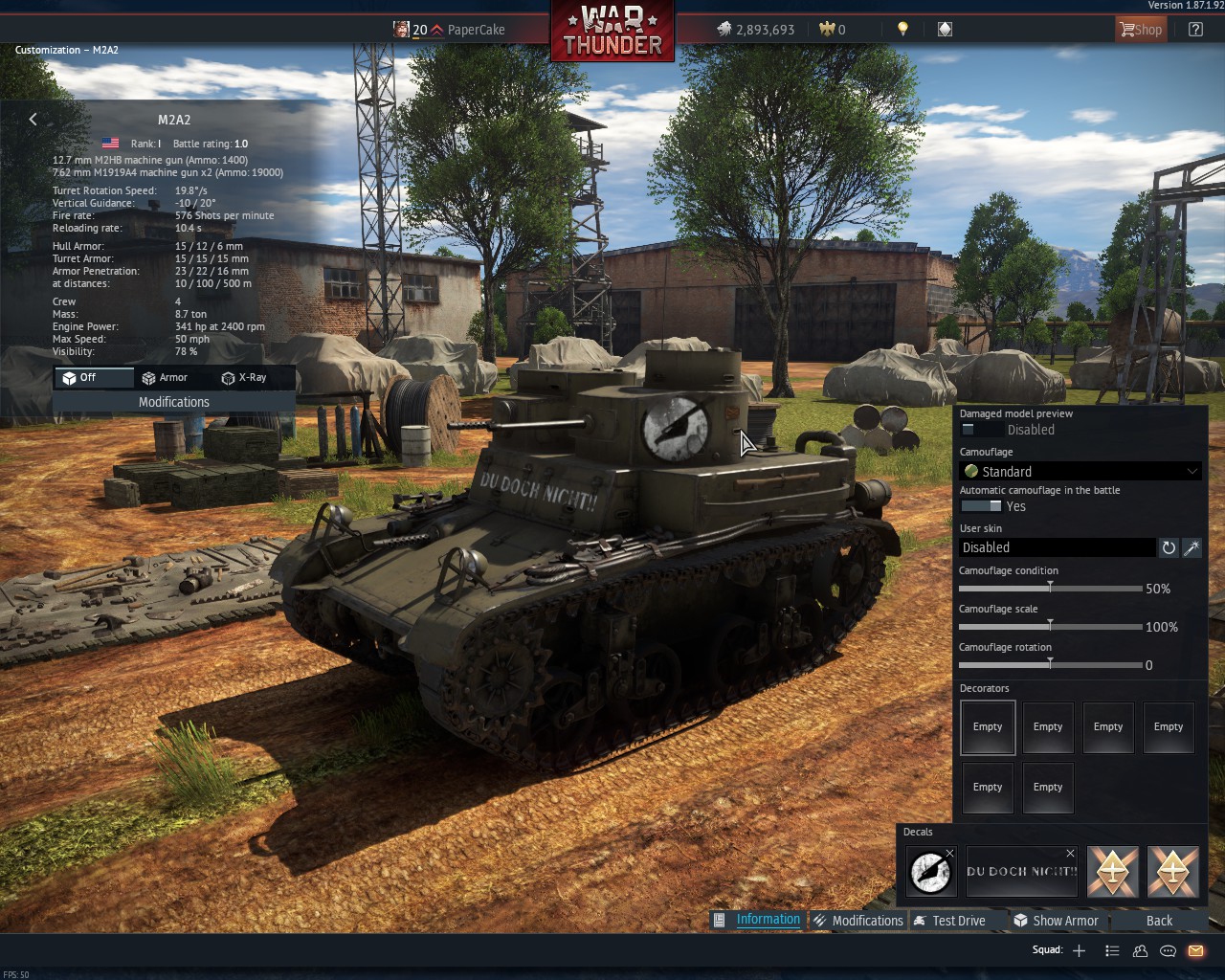
Then there’s its older brother, the M2A2. The M2A2 is one of the last M2 tanks to run the original style of machine gun turrets, albeit two in comparison to the single turret of the earlier M1 Combat Car. While well liked by troops in the field that earned it the name “Mae West”, the M2A2 pattern would be replaced quickly after the Spanish Civil War in favor of the M2A4 pattern. A few would bleed through into training, and some were picked up from storage for use in assaulting the Aleutian islands in Alaska but those tended to be left there.
And there’s pretty good reason why, what this tank has in speed it lacks in everything else. The main .50 BMG M2 Browning machine gun isn’t really a spectacular anti-tank weapon unless you gun it for specific other Reserve tanks and it’s only on one half of the turret with the other being a standard M1919 .30 cal. It’s more of a tank you end up taking because you don’t have any others, I advise you get another flavor of Stuart before this because trying to kill enemy tanks with this is as fun as trying to drive a nail into your ceiling.
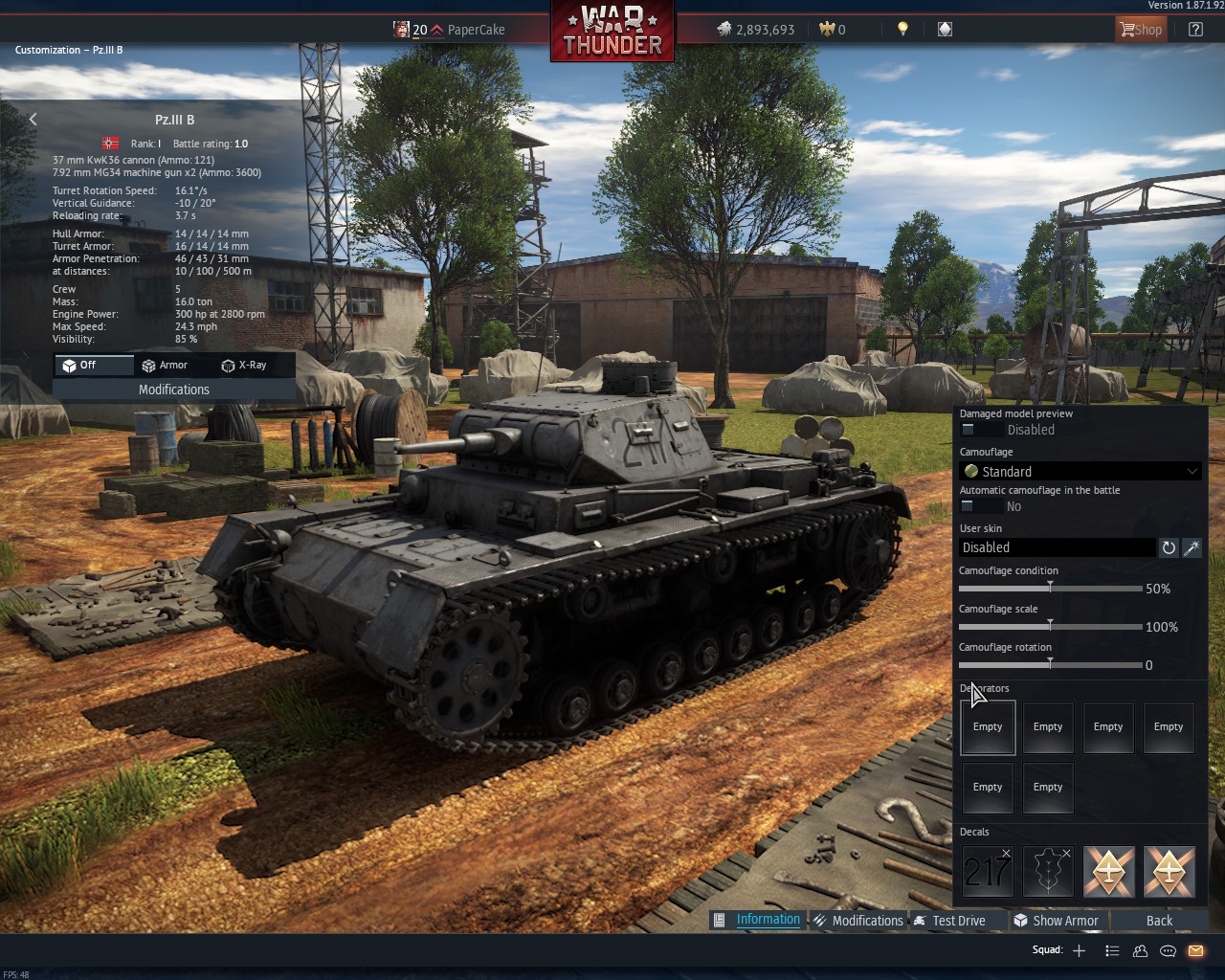
The Panzer III Ausf B is the first version of the III variation made, designed in 1935 based off of requests by German general Heinz Guderian. The idea that German doctrine had at the time was that the tanks would be split around basic ideas. There would be a proper tank for fighting other tanks with a high velocity cannon, a support tank with a larger gun for dealing with AT guns and bunkers alongside a mix of infantry support guns and light tanks. These would divide themselves into the Panzer III, Panzer IV, Panzer II and the original StuG. The III B specifically was made in 1937 and would stay in service until 1940 when it was replaced by later models of the Panzer III and scrapped entirely.
This serves as the introduction to the gameplay of the German Panzer series. poke out of cover, shoot, back up and don’t ever point yourself blindly forward unless you want someone to slap a round through the driver’s port. The 37mm gun is adequate for Tier 1 and a few Tier 2 tanks, the armor leaves a lot to be desired but later patterns of the III will easily get uparmoed so don’t lose any sleep over that problem.
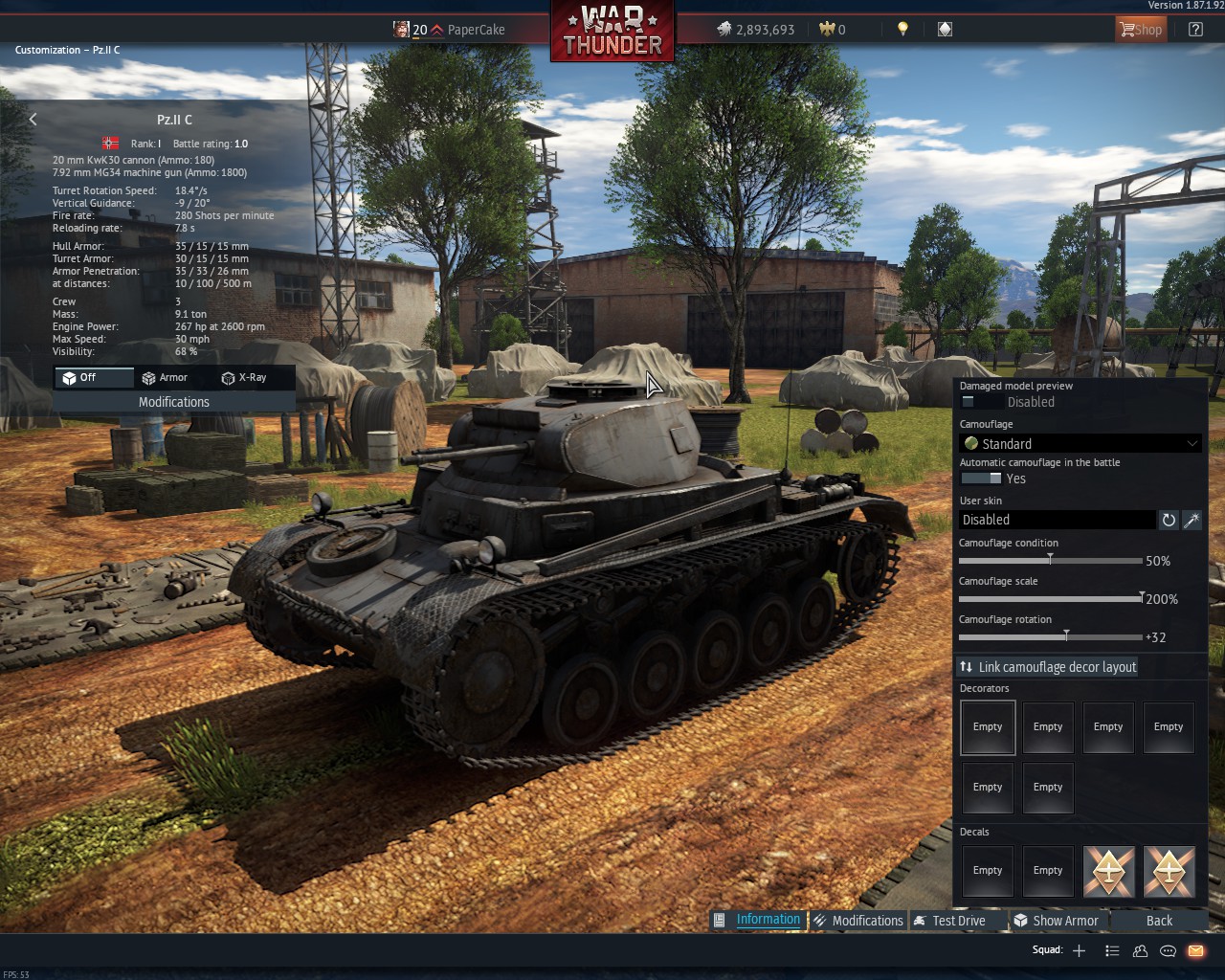
The Panzer II series was developed primarily as an emergency tank due to the designs for the later Panzer III and IV falling behind schedule. The German military put out a request for any type of tank to all major manufacturers who simply took the earlier Panzer I, added another bogie wheel and larger turret housing a 20mm autocannon and birthed the Panzer II. While in low production initially, the Panzer II would become far more numerous and be the standard issue tank to the German Army from the Invasion of Poland until well into Operation Barbarossa when they started to be replaced and by 1942 most were already being converted into Wespe’s and Marder II’s.
In-game the Panzer II is a decent enough light tank with nothing spectacular going for it. Decent frontal armor and a fast firing cannon are then immediately tempered by the slow reload of the cannon and tiny 3 man crew. If you can get it to the PzGr 40 rounds, you have a decent tank for shredding other light tanks but besides that, it’s nothing to write home about.
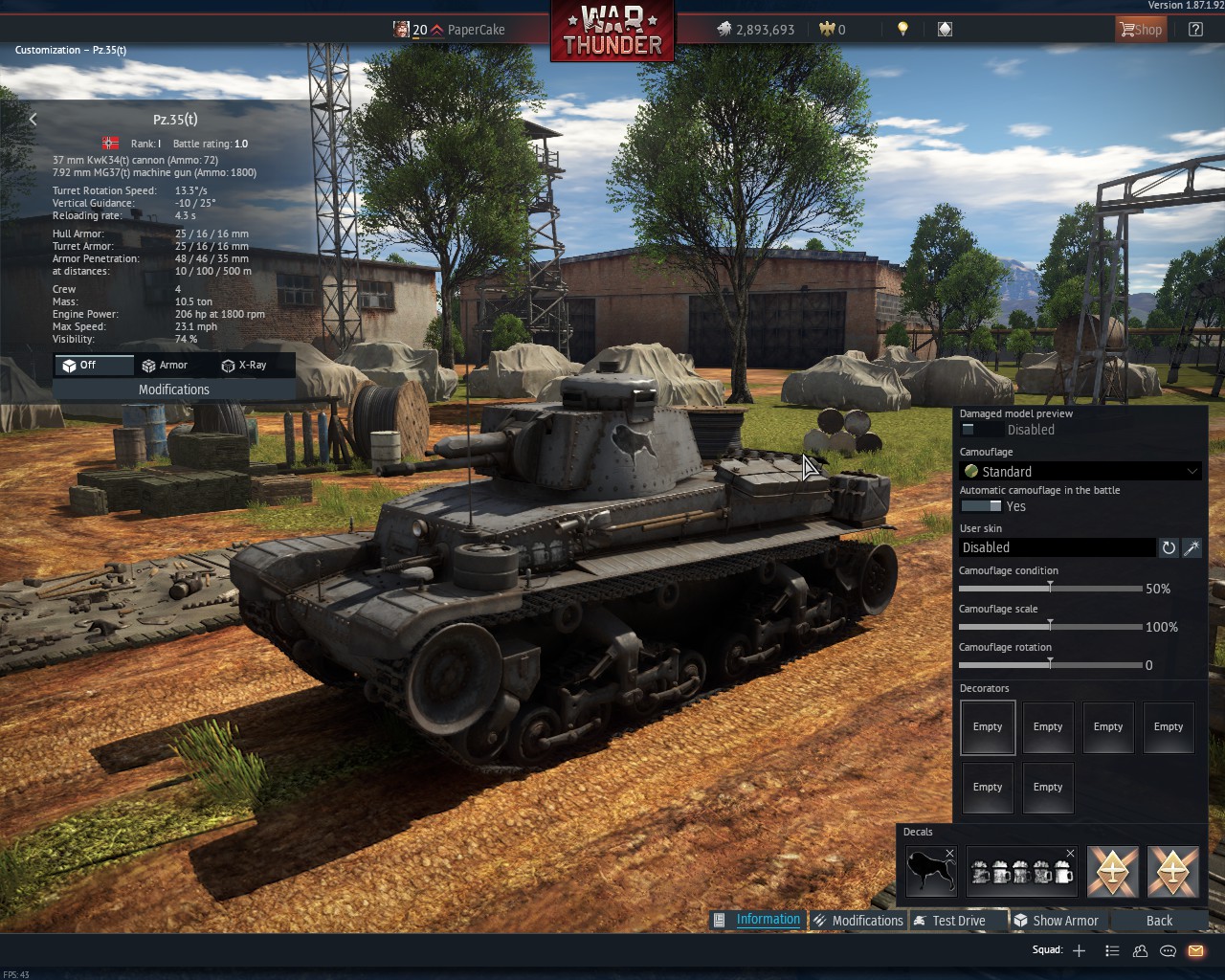
The Panzer 35(t) was a Czechoslovakian designed tank made from 1936 until 1940 when production was halted in favor of the updated Panzer 38(t). Developed by Czech cavalry request for a replacement for the Lt Vz. 34 tank, the Skoda made 35 competed with the CKD design in 1935 and won the trials, although many had to be repaired due to the rushed development. A decent medium tank, most of the 434 that were made were taken by the German Wehrmacht and used alongside Panzer II’s until 1941 and then retired alongside it’s later cousin, the 38(t).
As far as starter tanks go, the 35(t) is a deceptively average vehicle that brings nothing but decent to the party. Decent armor, a decent 37mm cannon, decent maneuverability and access to the later Czech designs deeper in the tree. It’s nothing super special but they’re effective slot fillers and good enough light tanks for early tiers.
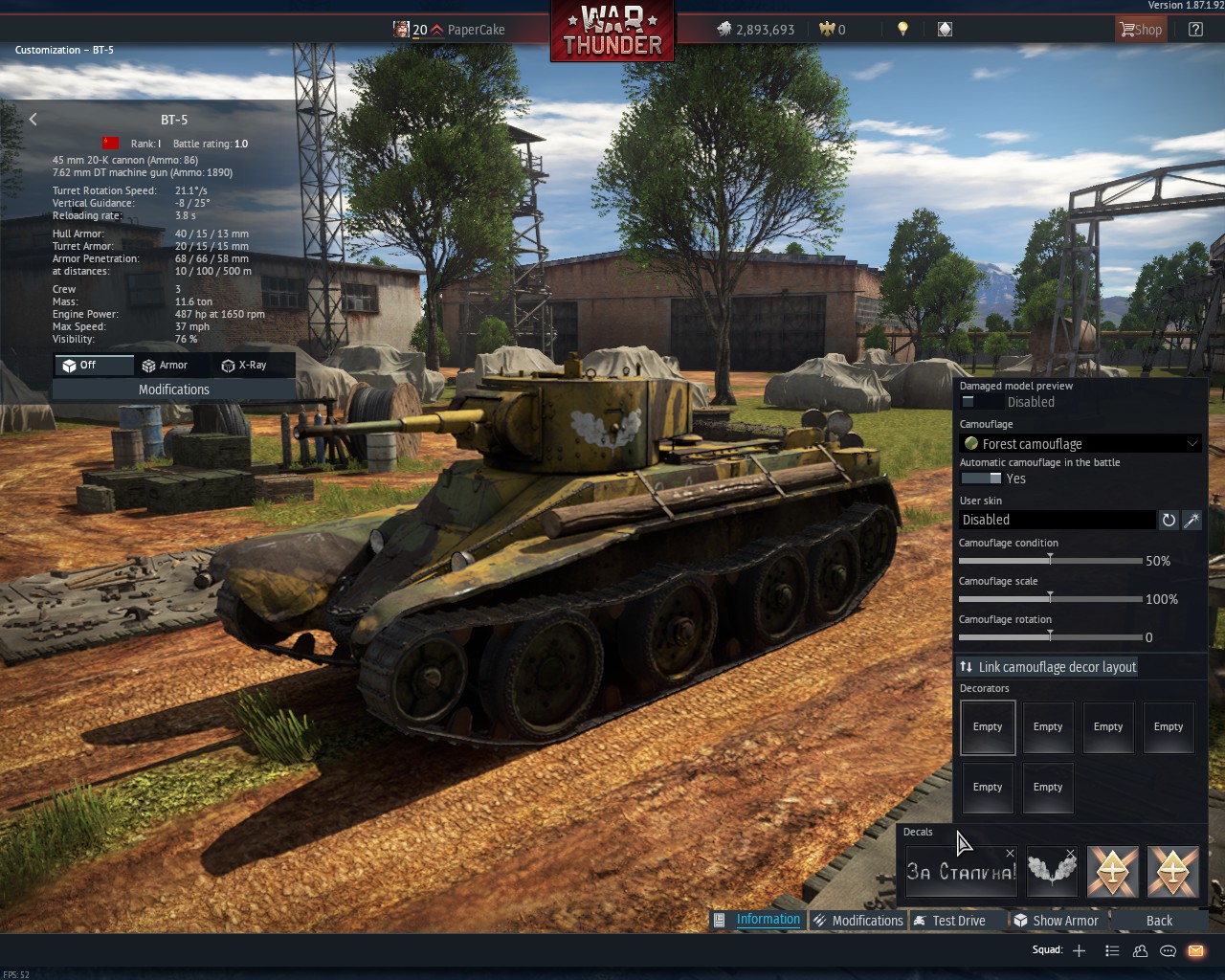
The BT-5 is a light tank developed in the early 1930’s with most of the work based off of American designer Walter Christie and his wheeled suspension system that allowed for tanks to both run without tracks as well as going with much higher top speeds. While many nations showed interest, the Soviets would be one of the only to actually go forward with the design in it’s original form. The Soviets bought the M1928 Christie tank and technical package, and over the next 5 years would refine it into the BT-5. While it had good marks in Khalkin Gol, the thin armor made it weak to anti-tank fire and by 1941, most were being lost to mechanical failure and German guns. By 1942, only 65 BT tanks were in service and it was entirely retired in 1946. Rather fittingly, an off shoot that was skipped over in favor of the BT-7 would later become the A-32, or the T-34.
In-game the BT-5’s a tank for speed attacks and not much else. The cannon, traverse and speed make it a shoe in for hit and run style tactics on heavier tanks but the small armor means that even small shots can go straight through your tank and liquifying your crew before you can even say “what”. Keep moving, keep firing and don’t even consider stopping and you should be able to wreck shop on enemy flanks.
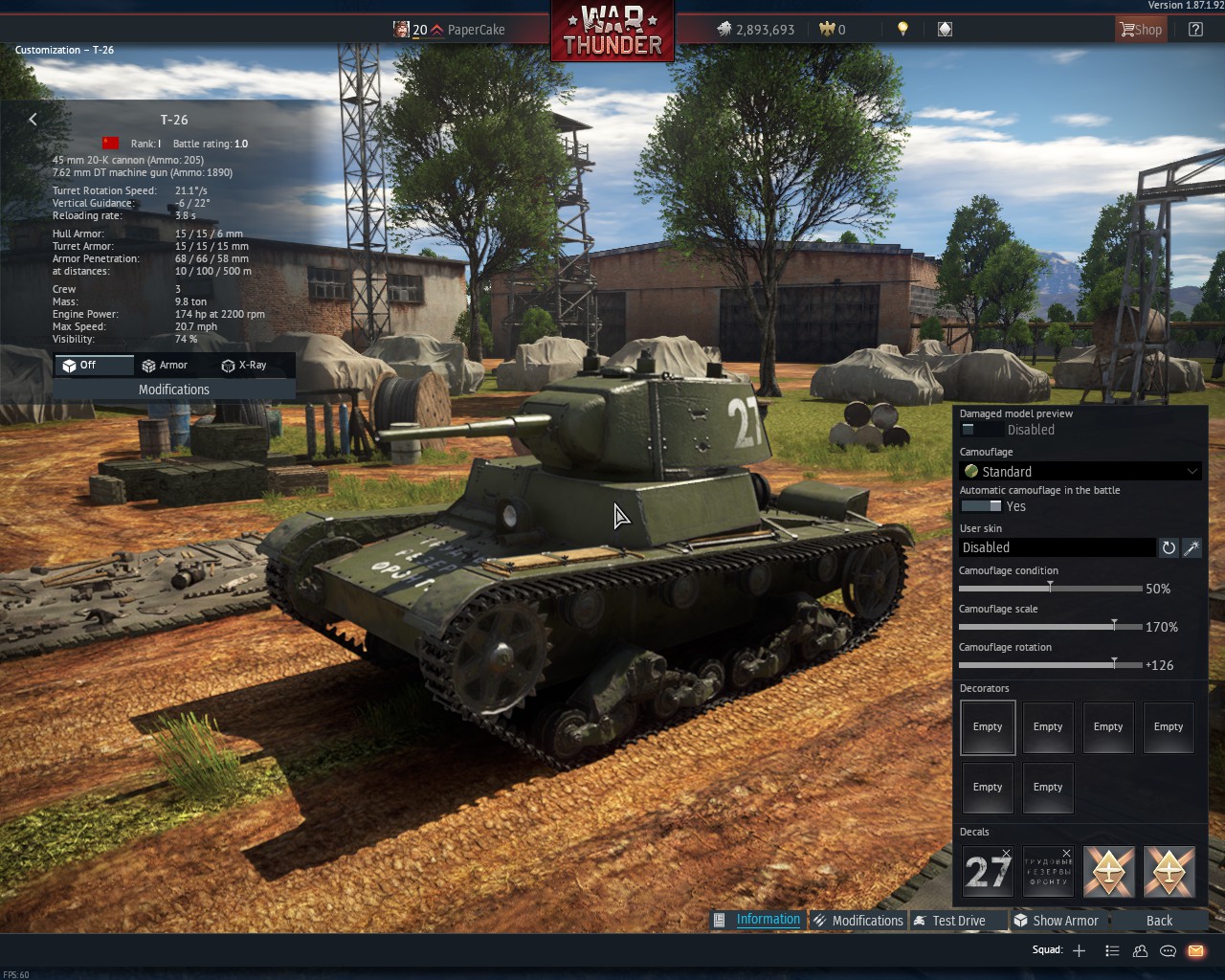
The T-26 is one of the first Soviet produced tanks, based off of the iconic Vickers 6-ton platform that sold like hotcakes around the world in the mid to late 1920’s. In the early 30’s, a Soviet buying commission ended up acquiring 30~ different Vickers models to pick and choose what would equip the Red Army. The 6-ton would go head to head with domestic designs, most note worthy being the T-19. During the trial, the T-19 recommended they mix elements of both the T-19 and 6-ton together and thus the T-26 was born and put into heavy mass production. While effective in the Spanish Civil War, later conflicts would reveal the age of the design especially the Winter War where they were susceptible to Finnish anti-tank gun and rifle fire. While replaced, the T-26’s sheer production numbers meant that it would show up periodically in rear reserve lines well into 1945.
This historical weak armor is this thing’s downfall in game, it’s honestly worse than the BT in that regard so you should treat it more like a tank destroyer than an actual tank. Keep it in the rear lines and use the 45mm gun to crack open enemy tanks rather than duking it out in the center of the map like your standard early Arcade match.
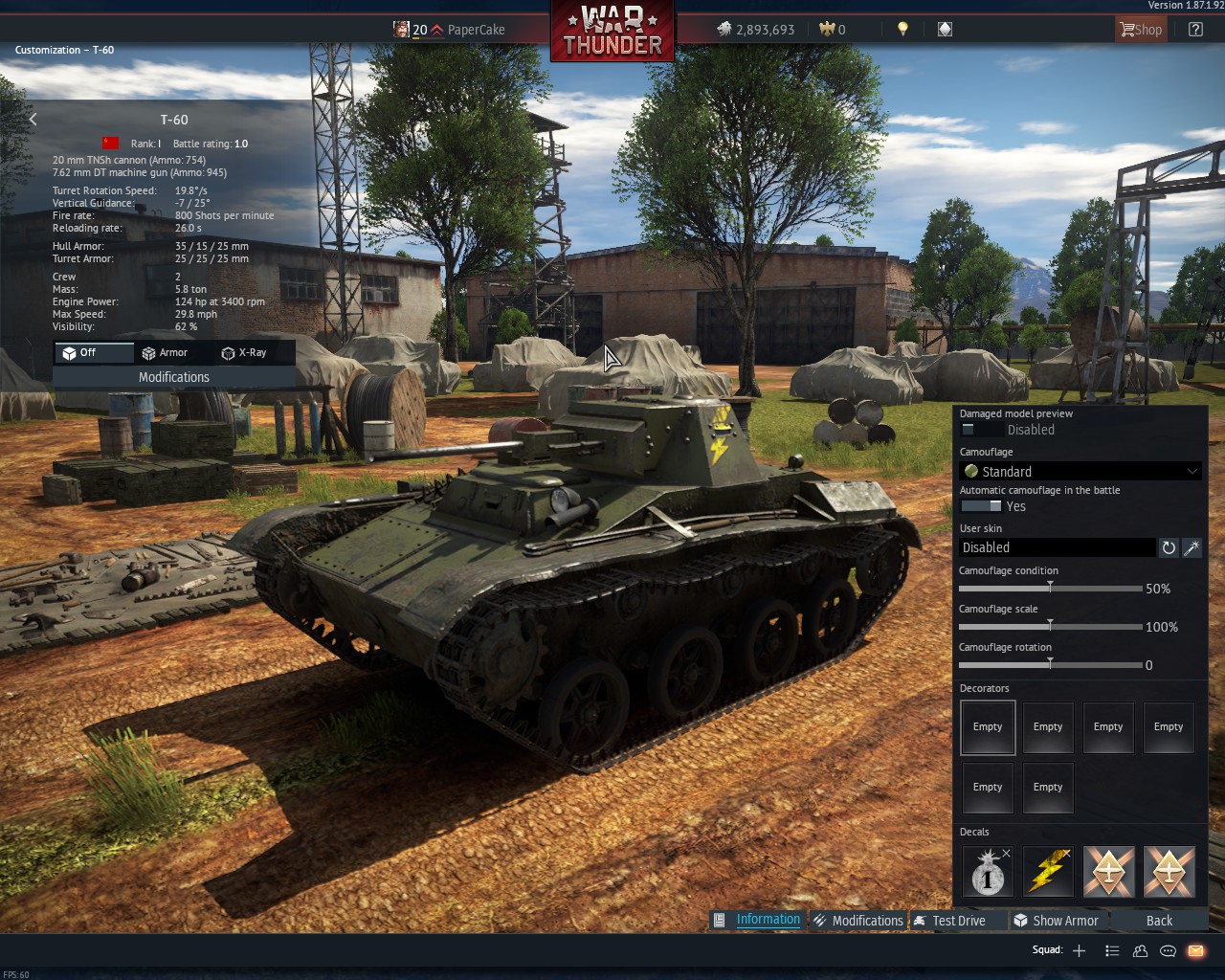
The T-60 is a Soviet light tank that was developed mostly as a scouting tank by Nikolai Astrov and his team at Moscow Factory No. 34 based on requirements for a amphibious and non-amphibious design. Originally born as the T-30, the designs would go into the T-30A and T-60 models, with the T-60 entering production right in 1941. Yes really. While initially armed with MG’s, the tank would be upgraded with a 20mm autocannon that borrowed from similar aircraft cannons. While this did increase it’s firepower, it was still hopelessly outgunned against any modern German tank and would be replaced by the T-70 within a few years. It would then become the test bed for many other designs including the T-90 AA tank and the infamous A-40 airborne tank.
And this extends to the tank in-game, it’s a pitiful tank that you only get so you can shove past it to the better T-70 and T-80. The 20mm has some pretty bad penetration, a horrible reload speed and a rate of fire so fast that you can’t even spread the rounds around like you can with the Panzer II. The armor is pitiful, the crew size is small and will get liquified if anything larger than a fart hits your tank, all in all it’s a terrible tank that I’m including more as a warning than anything else.
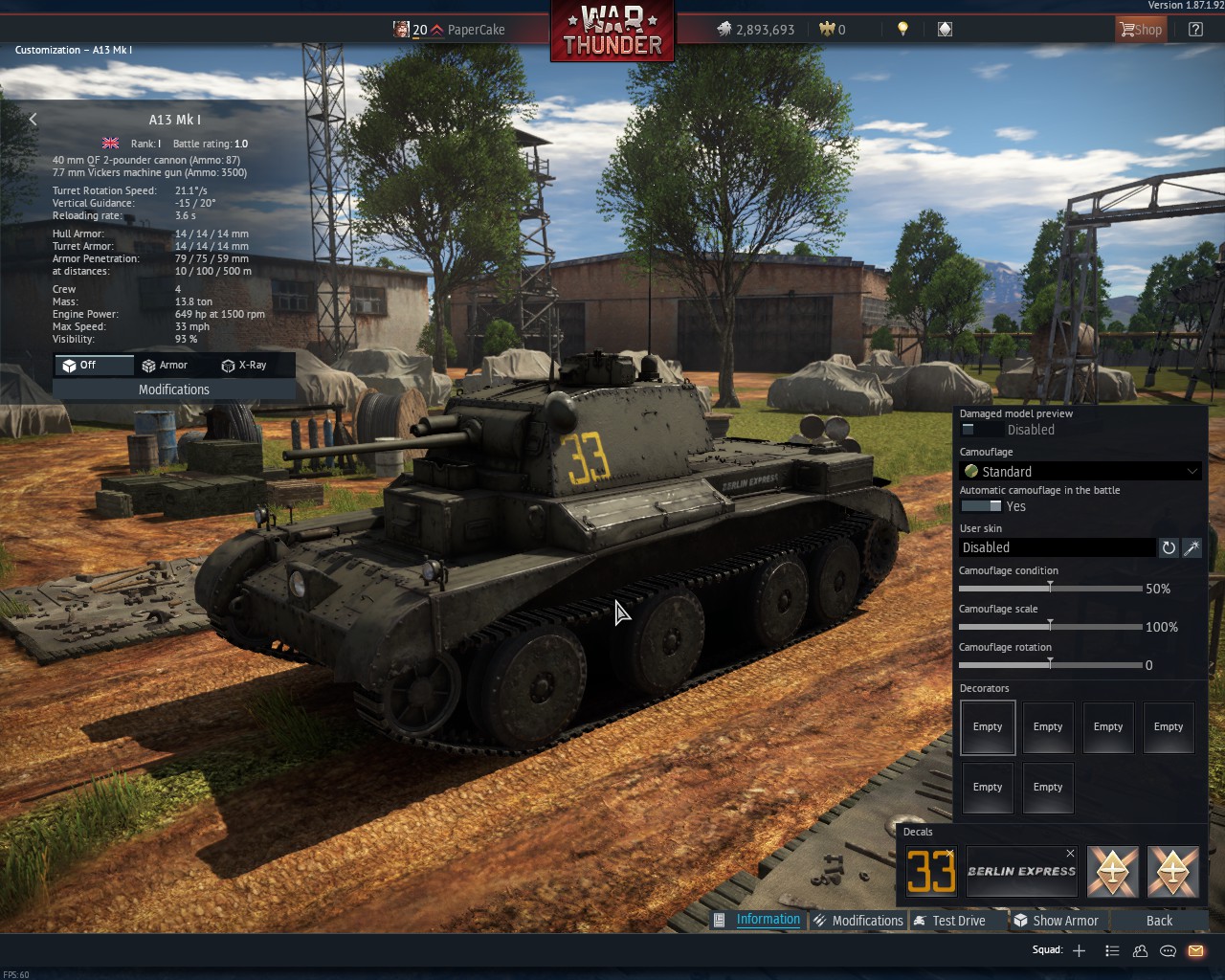
The A13 series of cruiser tanks were developed in the late 1930’s as light, fast tanks made to exploit breakthroughs was kickstarted when General Giffard LeQuesne Martel became the Assistant Director of Mechanization at the British War Office. Martel had seen a trial of Soviet tanks, and the big takeaway was the effectiveness of the BT series and thus he had the British push for a similar concept including Christie type suspension and high speed. The first A13 was delivered in 1937 and by 1940 enough were in service to arm the BEF for the Invasion of France. Their rushed development did keep back their usability as crews didn’t know how to use them but they did see decent success in areas like Greece and North Africa until they were replaced in 1941 by the Crusader series.
In-game, the BT-5 is the best direct comparison to how the A13 plays and feels. It’s a good maneuverable tank that only suffers when you hit the brakes and fire. The 2 pounder has a quick fire rate, some stabilization and good penetration up close to make it powerful for blasting parts inside tanks to make up for the lack of any explosive payload. Just make sure to keep moving.
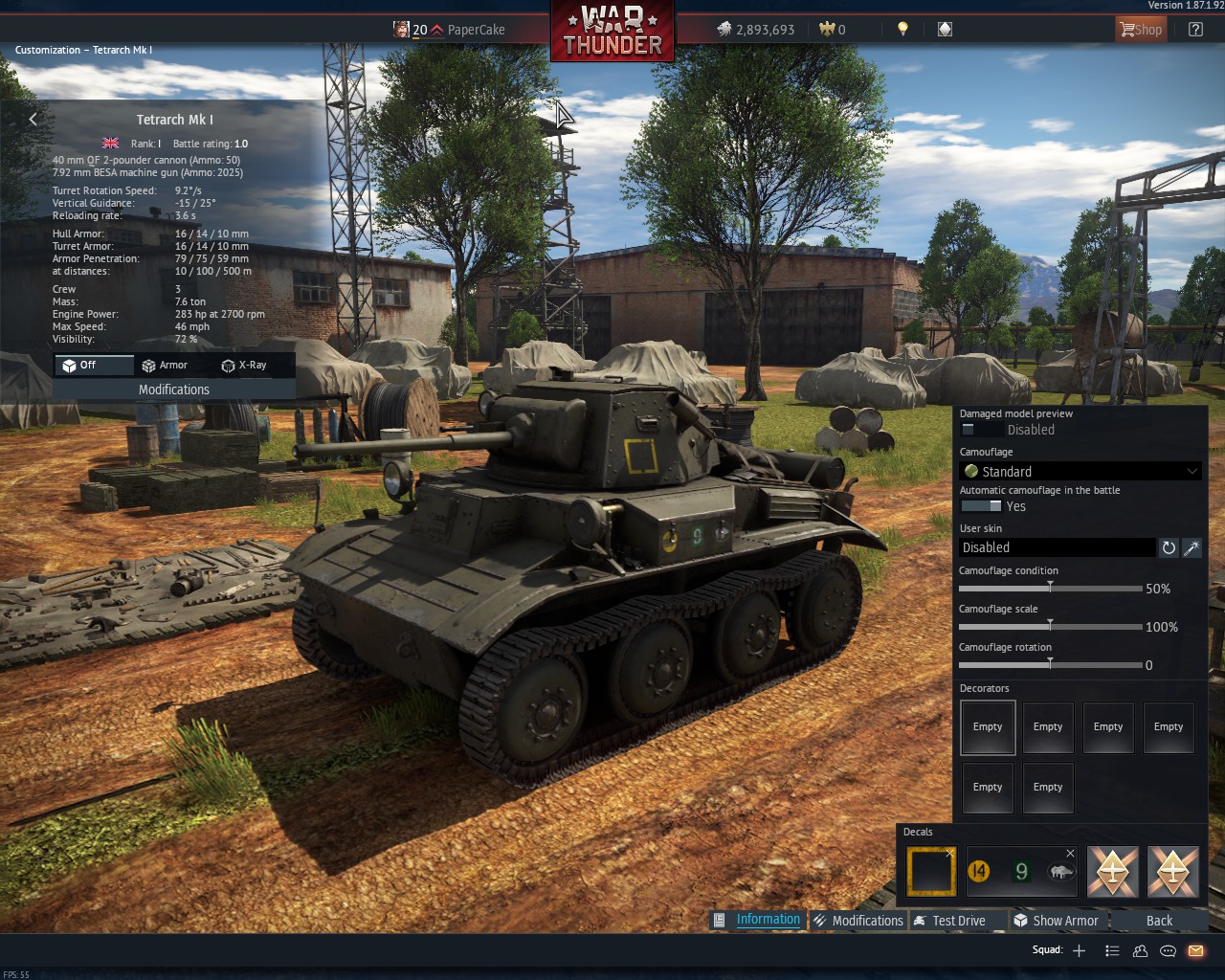
The Tetrarch is a bit of an infamous tank, albeit for the wrong reasons. It’s a pre-war light tank design now famous for being made into a paratrooper tank by the end of the war. Originally developed as the Light Tank Mk VII by Vickers Armstrong in 1937, the Tetrarch wouldn’t be adopted due to the A13 filling the role of light cruiser tank far better. In 1941 it would be adopted as a simple light tank, with around 220 requested. Production was held back by the Blitz as well as overall inertia due to the desire for such tanks being fairly low. While originally a mainline tank, by 1943 most Tetrarchs were handed over to airborne troops who used them on drops until November of 1944 when it was replaced by the M22 Locust. Tetrarchs floated in Army inventory until 1950 when they were finally rendered obsolete.
Like the A13, the Tetrarch is made to be fast and light and thankfully you’re not duking it out with Panzer IV’s and V’s like the real world tank. It’s a slightly smaller and slower A13, lacking the same speed but still packing similar armor and armament. You can use it a bit more loosely given the shorter length but do remember that your armor is made out of tea bags so don’t get too cocky.
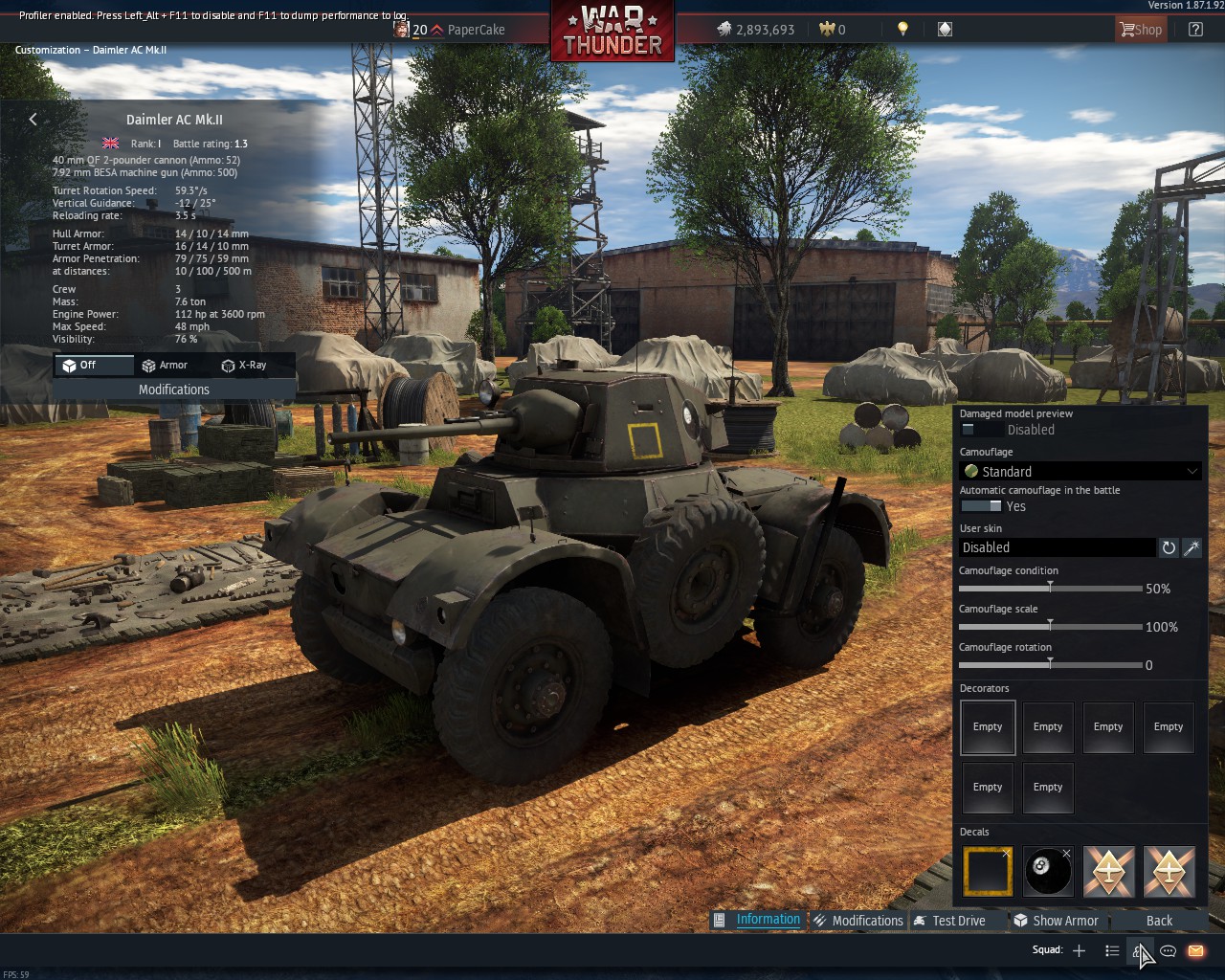
Following the Tetrarch is the Daimler Armored Car, specifically the Mk. II fitted with a 2 pounder gun. Designed as a larger version of the Daimler Dingo scout car, the Armored Car was fitted with the Tetrarch turret and a larger engine. While production started in 1939, the vehicle wouldn’t enter production until 1941 due to issues with the transmission. After that however, the DAC would have a long life span from WWII until well into the 1950’s in the Commonwealth as an internal security vehicle.
Take the Tetrarch’s overall small size and then make it faster and easier to move. While it’s not good past 2.0~, the DAC is a good replacement and slot filler for the early game as it operates similar to a light tank with better overall acceleration and so on.
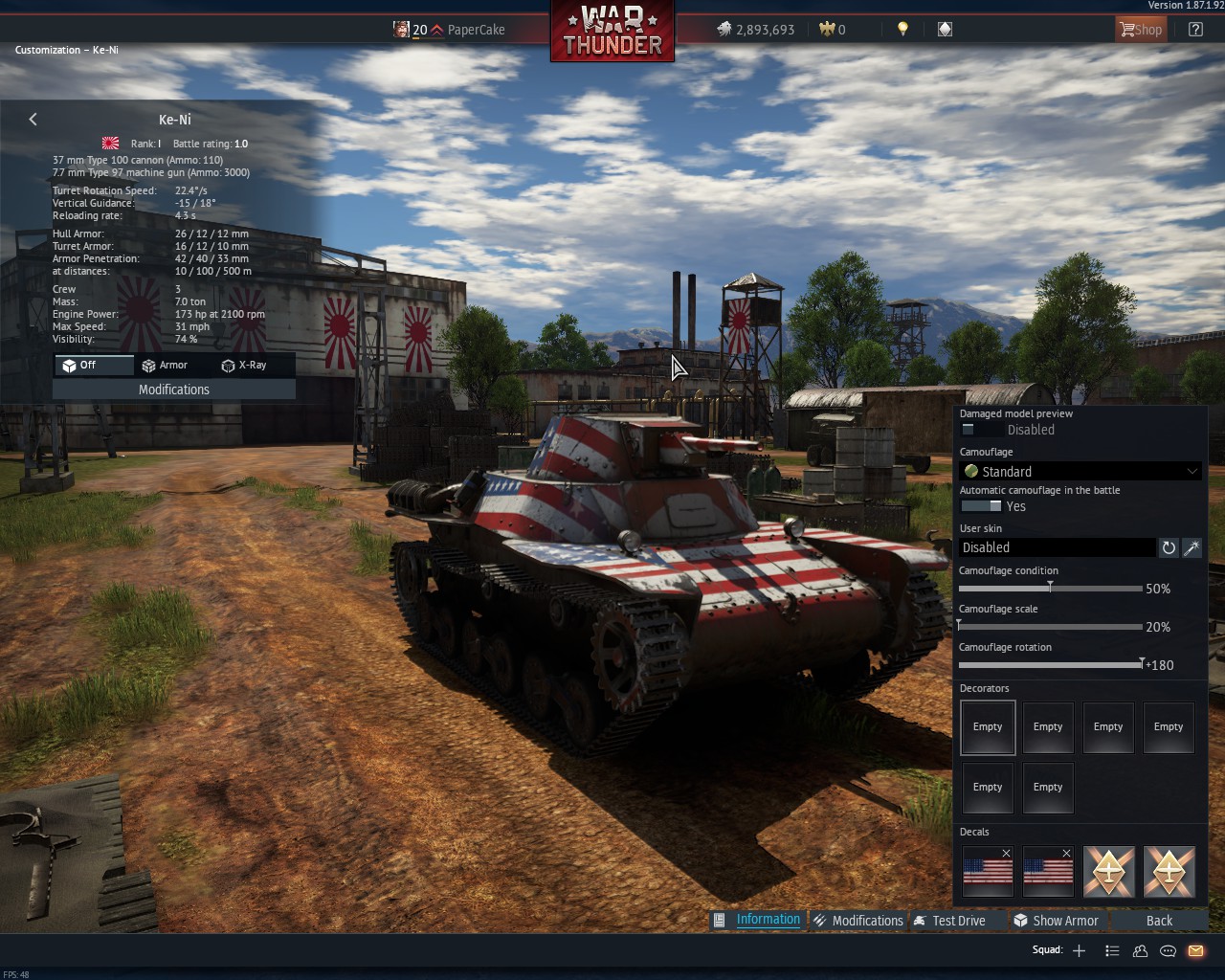
The Type 98 Ke-Ni is a small Japanese light tank built by Hino Motors as a replacement for the earlier Type 95 Ha-Go that while it did well in testing, wasn’t really pushed forward due to how acceptable the Ha-Go was doing against the tanks of the Republic of China. When 1941 rolled around and the Imperial Japanese military found the Type 95’s armor could be penetrated by .50 BMG fire, Hino was given a contract for tanks. Only 104 were made, mostly due to a majority of domestic steel being used for warships and aircraft construction over tanks.
Sharing the chassis with the Ta-Se AA vehicle, the Ke-Ni is a peppy little tank with a decent cannon and absolutely no armor which is the running theme with most of the early Japanese tanks. The armor is definitely paper thin, HMG’s and even coaxials can pen if you aren’t careful but the cannon putting out around 40mm of penetration makes it pretty good at peek and scoot tactics.
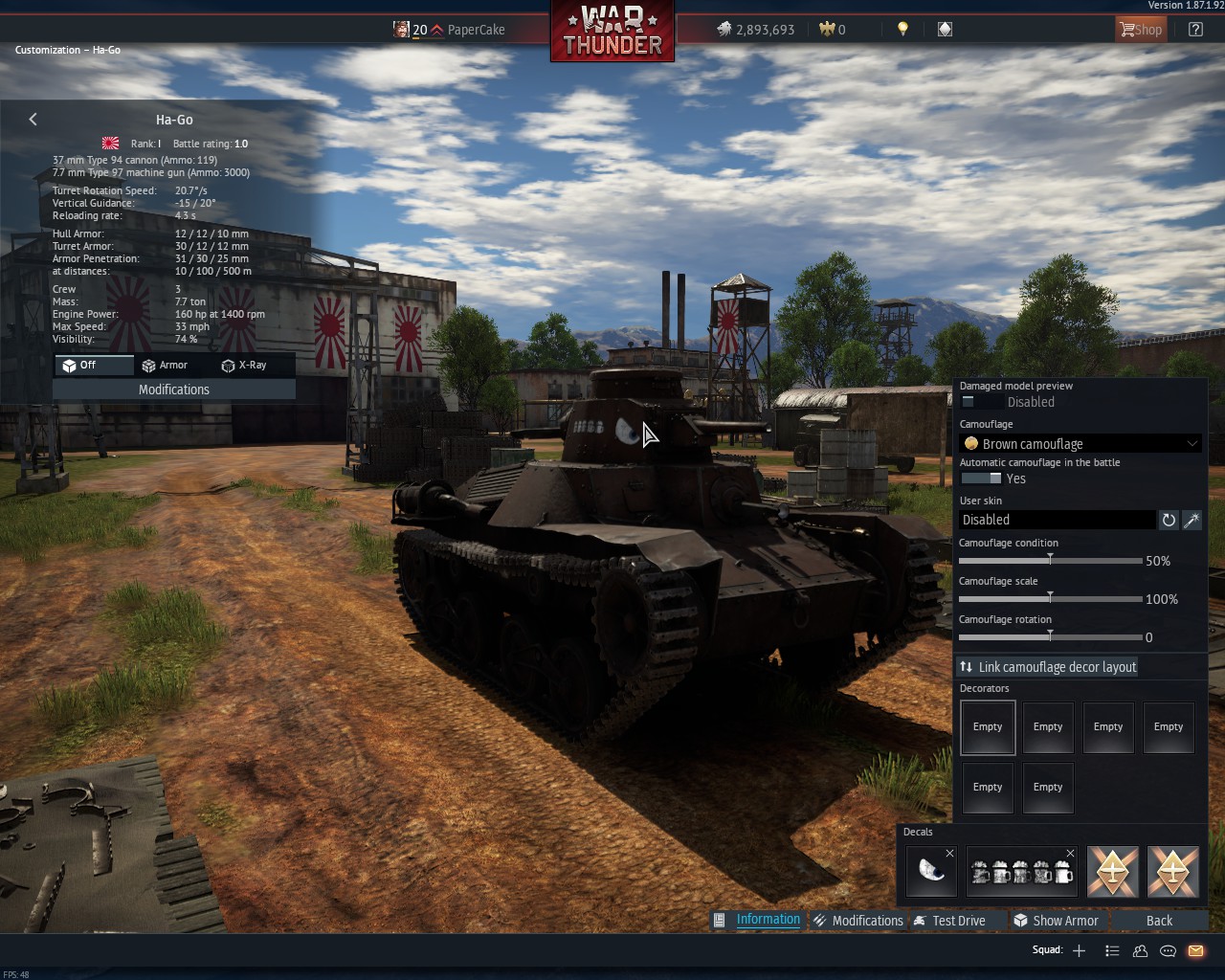
The Type 95 Ha-Go is one of the early tank options, and one I advise you pickup so you have a full set of 3 for screwing around with on AB. Developed from the earlier Type 89 I-Go-Ko, the Type 95 was made primarily for mobility to deal with the main complaints of the earlier Type 89 as well as the Type 92 Cavalry Tank. Balancing decent armor, armament and speed, the Type 95 would enter production in 1936 and would be made until 1943 with around 2,300 made making it one of the most common Japanese tanks of WWII.
The Ha-Go’s only advantage is its small size and speed, everything else pales in comparison to almost every other tank. The cannon’s a bit below average but it has good depression, a high speed and the small size allows you to be extra sneaky in big maps. But the low armor, small crew and terrible reverse speed make this a bit of a risky tank to go with.
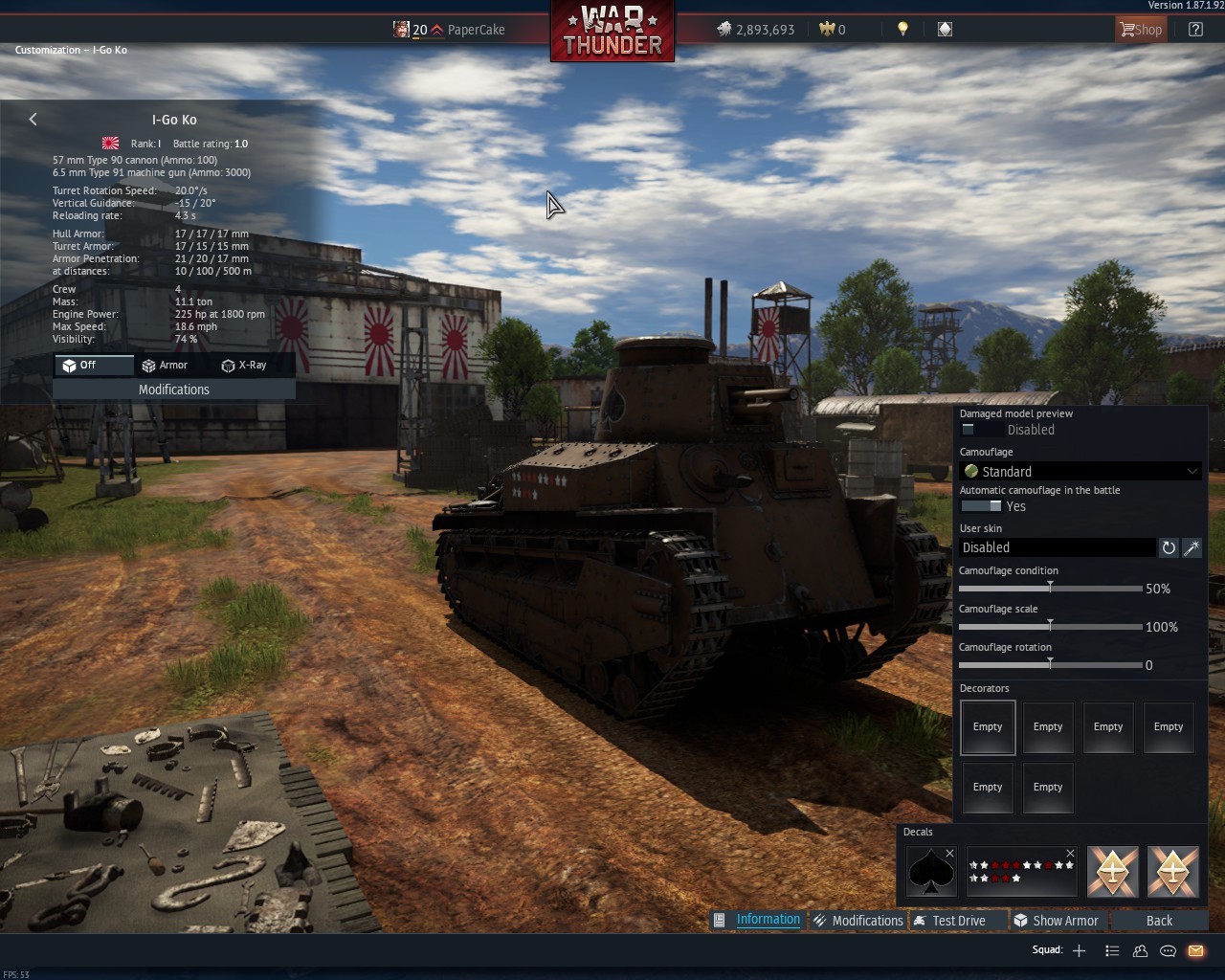
The Type 89 I-Go-Ko was one of the first properly Japanese tanks developed and produced by the Empire of Japan, made primarily to replace the mix of Renault FT’s and British Mark IV’s and Medium A Whippet’s that were in service. In 1926, the military requested some domestic design be made, and the 4th Military Laboratory would begin work on a new design. After a few years, the I-Go-Ko came out in 1929. First used in the Manchurian Incident, the tank did well in comparison to the earlier Renault and thus it would become the standard medium tank for Japan until 1939 when designs like the Chi-Ha would replace it. Even then, the I-Go-Ko still showed up both as a tank and armored pillbox, although American equipment made quick work of them. Hilariously, a few were kept around by the French during the Indochina War, with the ‘Commando Blindé du Cambodge’ unit using a hodge podge of other designs taken from the former Japanese occupants.
The I-Go-Ko feels like a tank from 1929 when you use it and there’s no way to curb that outside of the HEAT shell that it shares with the first version of the Chi-Ha. The armor is pretty thin, and while the tank isn’t sluggish despite its size, it’s still an easy target if you aren’t careful. Even with the HEAT round, the I-Go-Ko is still more of a light tank than a heavy.
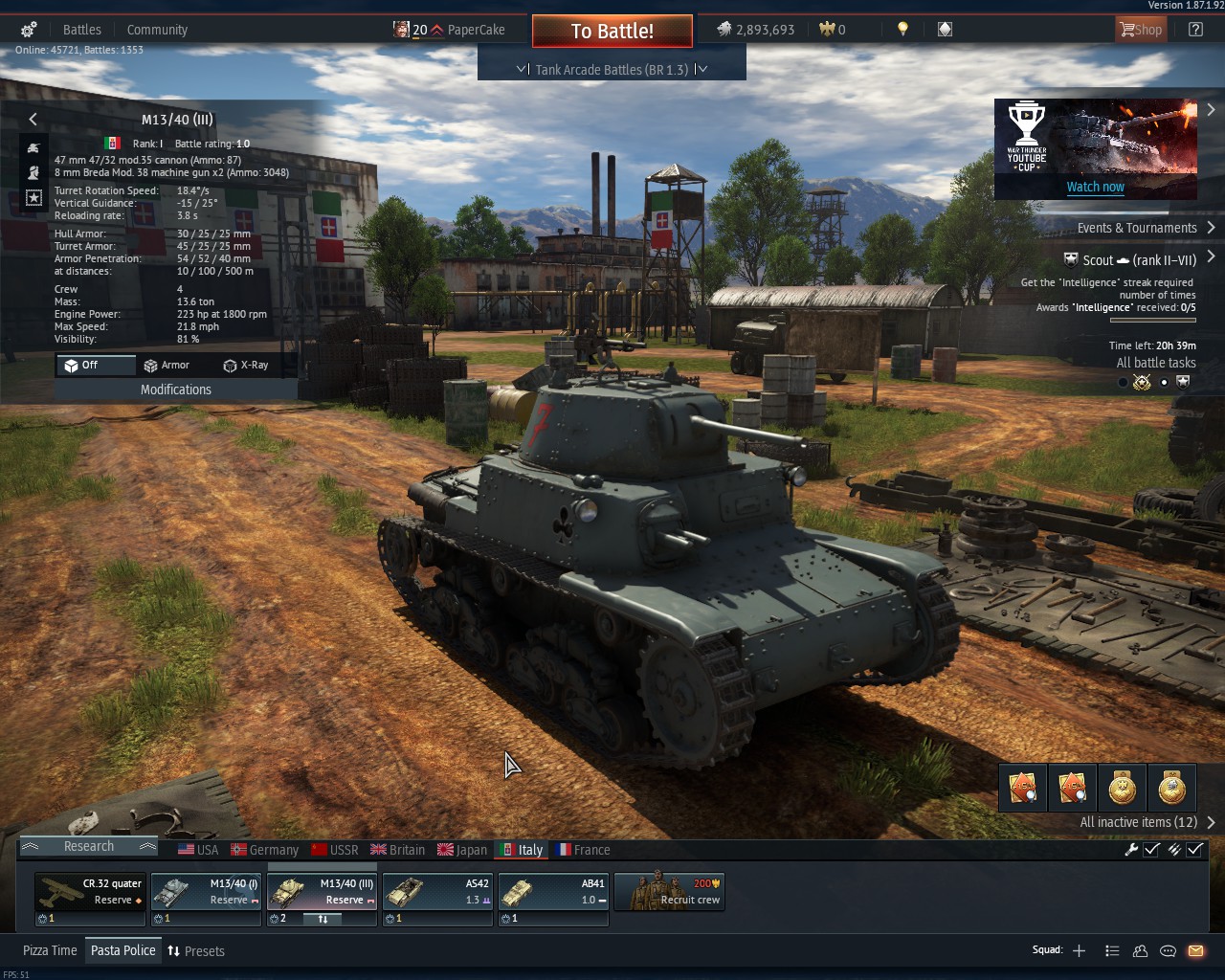
The Italian M13/40 tank was designed by Fiat as an in-general replacement for the Fiat L3 tankette, L6/40 and M11/39 that were in service at the start of WWII. Taking design cues from the Vickers 6-ton tank as well as the M11/39’s chassis, the M13 used a single turret mounting a cannon and machine gun over the M11/39’s turret mounted MG and pintle mounted cannon. While the M13 did enter production in January of 1940, the tank would be used primarily in the North African front over the Eastern Front and faired poorly due to Italian tank crews not being properly trained with the tank, the arrival of Shermans and many other logistical issues. A few would end up in Egyptian arsenals post war and used in the 1948 Arab-Israeli War.
The M13’s a potent medium tank for the early game, with a decent cannon, armor and overall mobility that make it decent for normal game and powerful in the right hands. The default ammo is potent at close range, it has good depression and can ping shots if angled correctly. It is a bit slow and you will be a tad boned if you’re fighting another M13, but keep at it and watch for SPG’s.
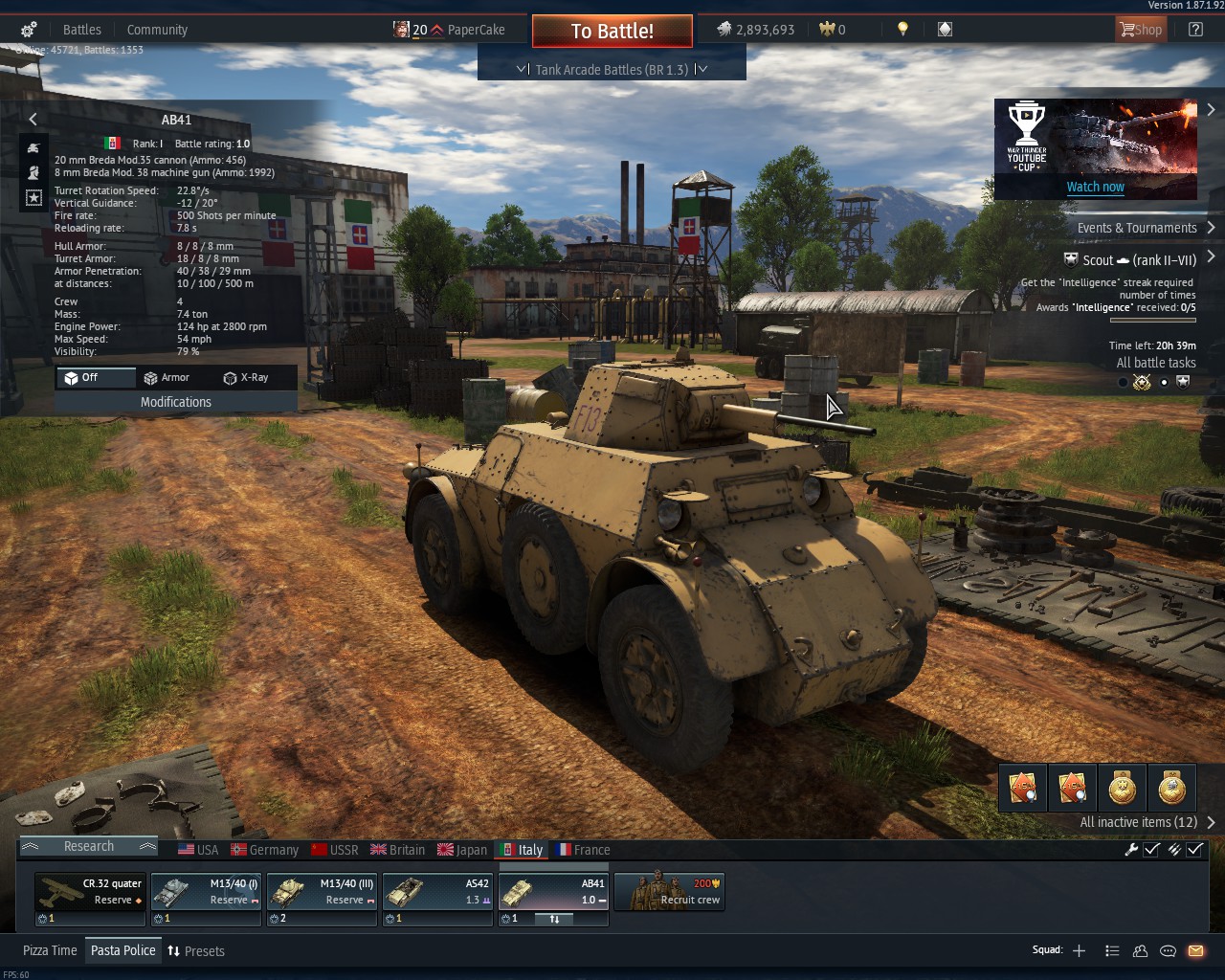
The AB41 is an Italian armored car that’s an easy unlock early game if you go pubstomping with the M13 like a madman. Developed for a military request for a lightweight armored car for military police and recon, Fiat and Ansaldo would unveil the prototype AB in 1939. After trials, the design would be adopted in 1940 and enter as the AB40. The AB40 was upgunned to a 20mm cannon in 1941 and dubbed the AB41 and a version with a 47mm gun was planned as the AB43 but Italian Armistice prevented that from happening.
In-game, the AB41 is similar to the DAC or other armored cars of the same rank. It’s a light tank with little armor, good speed and mobility and only lacking in the arms department. The 20mm cannon does have decent ammo but the magazine size is small and takes a little work to get running right. Place your shots right and you’ll eat through light tanks like nothing else.
Until you use them. You will now feel the absolute fun that was French tank doctrine with the H.35, H.39 and the AMC.34. Two man crews, no horsepower and god forbid you even think about going near a hill and actually penetrating armor.
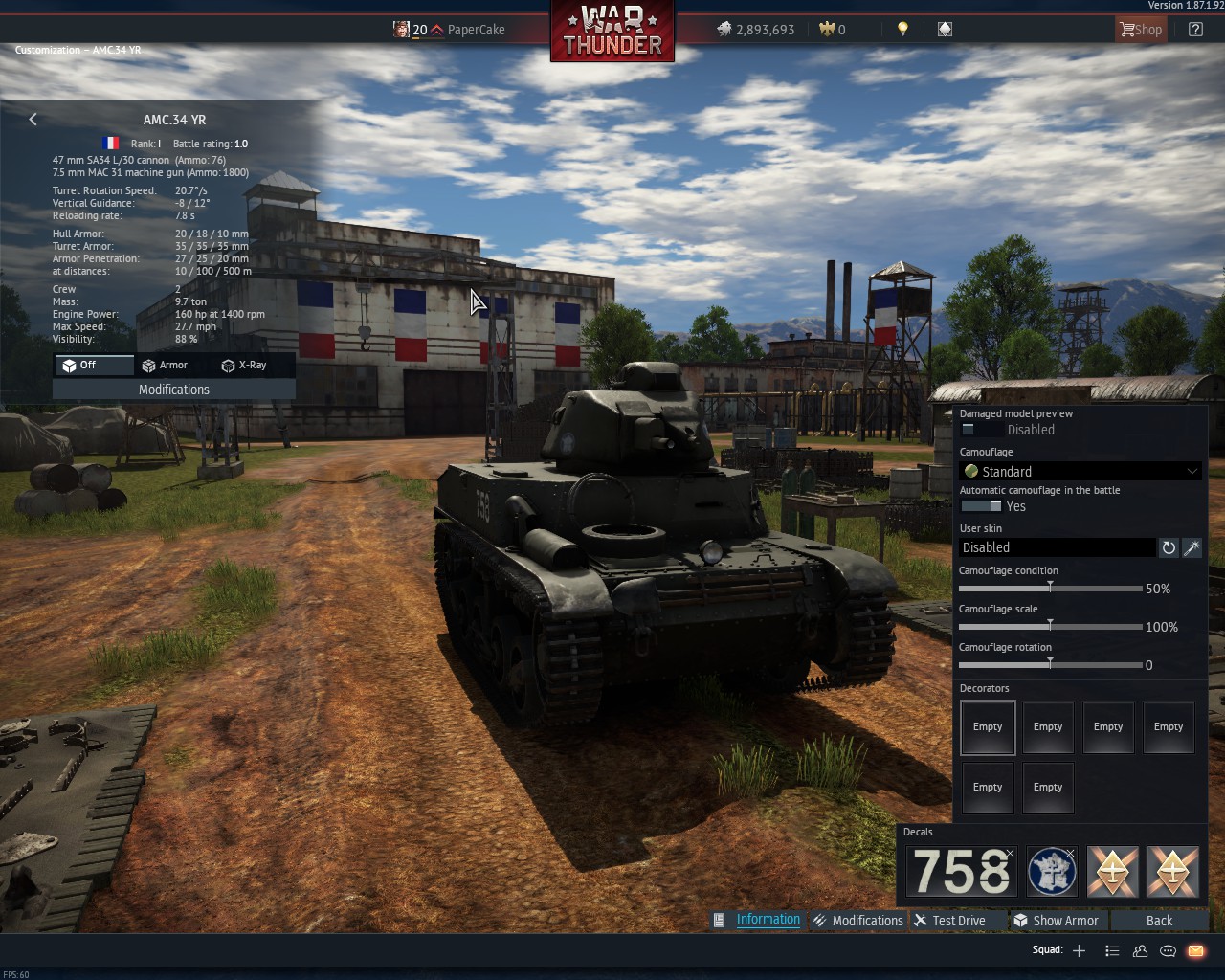
The AMC.34 is weird historically, it’s a French light tank that didn’t really see service at all. Not even to the M2A2’s extent. It’s confusing. In 1931, France began to heavily invest in tank production as they watched the Soviets rapidly build a tank program. This scramble would see the French Cavalry deciding on tank designs. The idea was to have fast, heavy hitting light tanks or “Automitrailleuse de Combat” in service alongside normal infantry designs. Louis Renault would put his team to work on a new AMC style tank and by 1934, the AMC 34 was ready to go. It did, and then by 1939 most had been replaced by other tanks and scrapped.
The AMC. 34 is a terrifically terrible tank to use, and it will make you hate the French tree. The armor is a 50/50 between decent turret armor and absolutely terrible body plating, the engine barely gets it moving and the ammo does a whopping 27mm of penetration at 10m. There are machine guns that can do better.
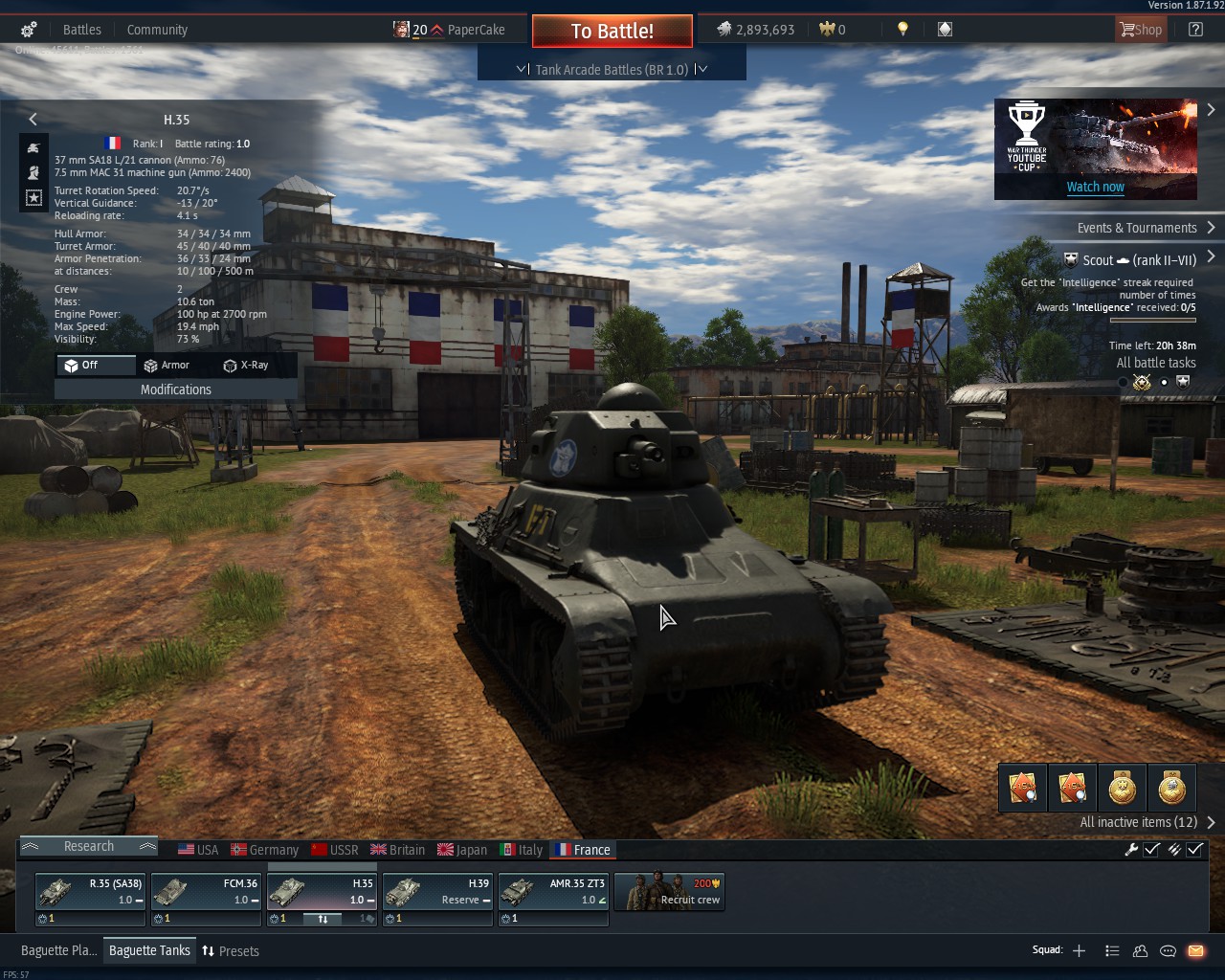
The H.35 is another French light tank of the pre-war era, designed to be a cheap and simple infantry tank to support troops and maybe fight tanks if it really felt like it. The Hotchkiss company had submitted a design for a lightweight tank made primarily of cast steel for the body, the idea was well liked and the French military approved the proposal but Hotchkiss was beaten to the punch by Renault for the design while Hotchkiss didn’t even have a prototype ready in proper armor steel. And when it arrived, it was rejected for being terrible off road. But French politics kept the thing in production and H.35’s were given to the Cavalry or else they wouldn’t get funding to get their own designs.
Yes really. They blackmailed them to take the tank. That’s a good sign isn’t it.
In-game, this is the tank that will make you want to give up on life because it’s astoundingly terrible in every way except armor. The cannon is the same one off of the WWI era FT and has mediocre penetration, the engine is stupid underpowered and will not propel this tank forward even with upgrades so give up on climbing a hill, and the small crew means one good shot to the center of the tank will liquify your crew into a fine pate. Give up now.
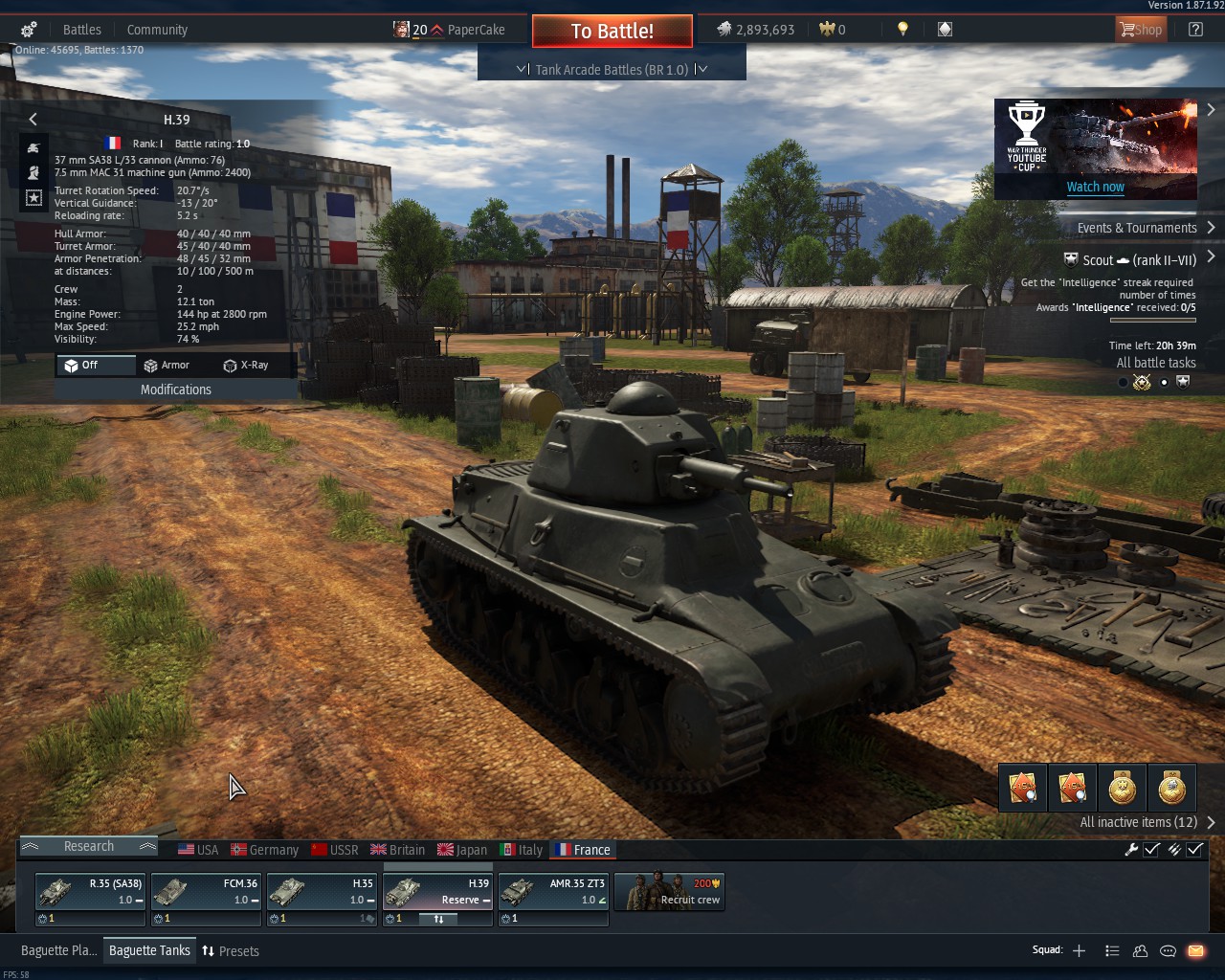
If you haven’t given up on life yet, then the H.39 will save your soul. At least it’s trying to. The H.39 was developed by the Cavalry to make the H.35 suck less, at first by giving it a 120 hp engine over the paltry 78 of the original H.35 and subsequently more upgrades as time went on. The hull was enlarged, the track and suspension was improved to actually make the tank drivable, better ventilators, a radio and an improved cannon. Around 350-400 H.35’s were upgraded to the H.39 pattern before the German invasion, and plans for an upgrade from there was dropped so they could finally forget about the H.35.
The H.39 is the one saving grace of the French reserve tanks, it’s actually good. It can go decently fast, the armor can tank shots decently well and the gun isn’t terrible, if you have to keep any of the reserve tanks then this is the one to keep. And the only one. Don’t suffer for the art.
1: Don’t fight everything that moves, sometimes doing the objectives will get you more points than chasing down every T-26 that you see.
2: Always check the rank of the tanks you unlock. This sounds pretty basic, and it is, and yet every so often I will see someone who marathon’d a tree so hard that their lineup goes “2.7, 2.0, 1.3” and then they act surprised when they get killed driving a pre-WWII tank in the middle of a 1943~ firefight. I know, you might want every flavor of T-34 ever made in your line up for maximum Soviet but don’t act surprised when you get uptier’d into a 4.0 match because one of those is 3.7.
3: Balance everything. This ties into the bit above as well, but it still is something that needs to be said. Get good tanks that balance each other out, think like the French tree, balance out the H.35 and AMC with something actually good.
4: Gamble a little bit, sometimes playing it safe doesn’t do anything. Don’t go crazy but sometimes flinging a tiny tank into a match might help win it.
Related Posts:
- War Thunder Top 5 Best Nations Tier List 2022
- War Thunder: Fully Named Italian Tanks
- War Thunder: UFO Controls Guide
